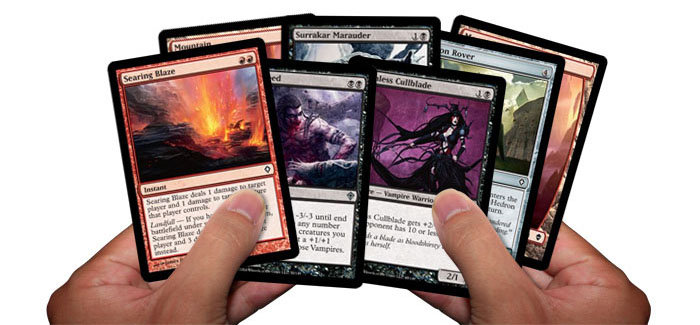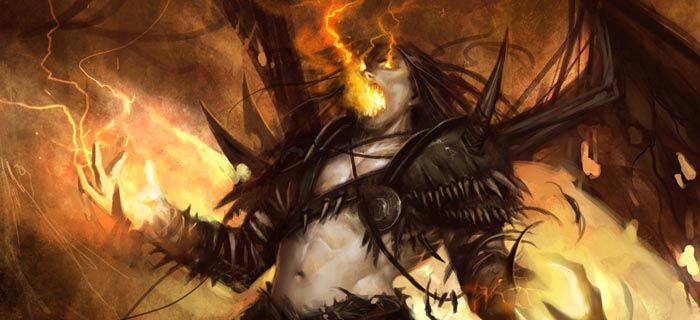School of Poker: Learn your odds
You still suck at poker. I know, after reading my last article, you figured you’d be ready to go on to the World Series and win yourself a purty bracelet. But no, you still suck more than a cheap hooker trying to pay for law school. Why? Because you don’t know jack shit about your odds in a hand. It’s impossible to play profitably without knowing the numbers going on at the table. Contrary to what I keep telling the guys at my Friday night game, you don’t need to have a degree in statistics to figure this out (though a Ph.D. in Horribleness couldn’t hurt). So today we’re going to talk about the simple math needed to fully understand whether you should call, fold, or send a check or money order to 1337 Top Tier Tactics Ave.*
Pot odds
Every call you make after the flop is based on the odds of making your hand compared to the pot odds. Pot odds refers to the amount of money you need to put into the pot to call a bet versus the size of the pot (or if you’re playing in a college dorm room, it’s the odds of your opponents smoking a ton of pot and being unable to make good calls because they’re too distracted by how weird their fingernails are). Even if all you have is a pair of deuces, you’ll want to call if the pot is $1,000,000 and it only costs you $3 to call.
For example, if the pot is $500,000 and someone makes a $500,000 bet, then your pot odds are 2:1 (the $1,000,000 that’s already in the pot against the $500,000 that you’re being asked to put in). For calling this bet to be profitable, you need a 33% chance of making your hand. The reasoning behind this is simple. For the sake of example, let’s say we’re flipping a coin. Every time it comes up heads, you give me $1. Every time it comes up tails, I give you $1. If we do this a couple of times, you will have the same amount of money you started with.** However, if we change the amount so that you still give me $1 on heads, but I give you $2 on tails, you will have won the same number of flips but you’ll have made $0.50 per flip.
Knowing your hand’s odds
But Ferret, you may be asking, tears beginning to swell in your eyes, how do I know what the chance of my hand winning is? Don’t cry, it’s quite simple. The first thing you need to know is how many “outs” you have. An out is any card that will make your hand, based on your cards, and the cards on the board. For example, if you have JhTh (the jack of hearts and the 10 of hearts), and the board is Ks9d2c, then you have 8 outs. Any ace or 8 will give you a straight, and likely the winning hand. There are four aces, and four 8s in the deck, which gives you eight outs.
Keep in mind, though, that making your hand doesn’t always guarantee that you will have the winning hand. In the example above, if all the cards are the same, but everything on the board is diamonds, you have the same chance of making your straight, but someone may already have a flush. In that case, instead of eight outs you have zero outs since no matter what card comes out, your straight still loses to their flush. Often times this requires determining what cards your opponent may hold, which is called putting them on a range. We’ll cover that in a later article.
Even if nobody has a flush yet, they may hold the ace of diamonds or one other diamond, in which case any other diamond will give them the flush. Let’s look the example again, but only two cards are diamonds this time (You hold JhTh, the board is Kd9d2c). In this case, when looking at your outs, you need to take into account that any diamond could give your opponent a flush, thus making you cry like a baby, lose your rent money, and have your wife leave you because you’re so terrible at poker. While there are still eight cards that will give you a flush, two of those cards are diamonds, and could give your opponent the winning hand. These outs are no longer considered “clean”, and you can’t count them. So now you only have six outs. You could count your dirty outs or “anti-outs” as 1/2 an out, but really, you just need to stop sucking and figure out how likely it is that they’re holding a hand with two diamonds in it.
What are these out things good for?
So now you’re an expert on calculating outs, you’re certain that you’re going to win the hand, get a shit-ton of money, get innumerable women/men/donkeys/whatever else you’re into and get laid constantly, right? Wrong. The math isn’t done yet. You need to convert your outs into an actual percentage chance of winning the hand. To do this, you’re going to need your abacus, a calculator ready to graph a few logarithmic functions, and a team of undergrad assistants ready to determine the Nth digit of pi. Or you could just use what we call the 4/2 rule.
The 4/2 rule is incredibly simple. You take the number of outs you have, and multiply it by 4 on the flop, or by 2 on the turn. That number is your percentage chance of winning the hand. Keep in mind, though, that the number you get on the flop assumes you’re seeing both the turn and the river cards. If you’re facing a bet on the flop, and you plan on folding on the turn if your hand doesn’t improve, then you need to multiply by 2 instead of 4 to see your odds of winning.
After figuring out the pot odds, and your odds of making your hand, you can make a decision as to whether calling a bet is profitable or not. If your chances of winning are larger than your pot odds, then you should call. If it’s smaller, you should fold. It really is that simple!†
Implied odds
But wait, there’s more! Call a bet now, and you may be able to make even more money on the turn or the river! It’s true! If you have a 16% chance of making your straight by the turn, and you’re being asked to put in 25% of the pot, it may still be a profitable call. While you may be putting 25% of the pot in, if you make your hand on the turn in this situation you can likely get another bet out of them on the turn or the river and have the best hand. This is known as implied odds, and can be used to justify a call even if you don’t have the proper pot odds. There are several things you need to look at, however.
The first thing to keep in mind is how much money you and your opponent have left in their stacks. If either you or your opponent have only five big blinds left, you don’t have good implied odds. You also need to consider what hands they may have. If you think they have some garbage like middle pair, or another draw, then they will likely fold if you try and get money out of them on a later street.
Understanding your odds is key to becoming a solid poker player. Even if all of your calls are only 1% in your favor, knowing when you have that 1% edge and when you don’t is what makes you money. Blindly playing your hand without taking all the information into account is what makes you a losing player, and I won’t be there to bail you out when you bet your car on a losing play. Tune in next week when we talk about hand ranges. Or whatever the hell I end up writing about.
*Spoiler alert, you should send us the check.
**When looking at these kinds of odds, we ignore the randomness of the particular hand. Over a large enough sample of hands, things will have played out close to how the odds say they should.
†It’s not really that simple.








This is a test comment
Lies
It’s amazing how many people agree with you here. Nice writing style.